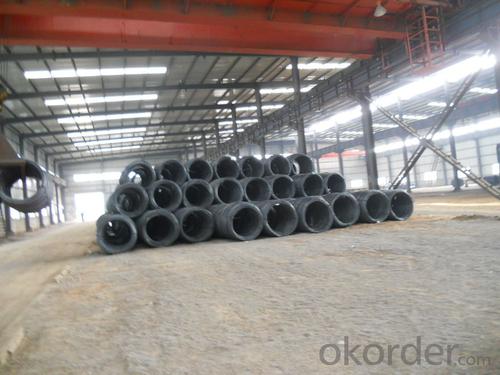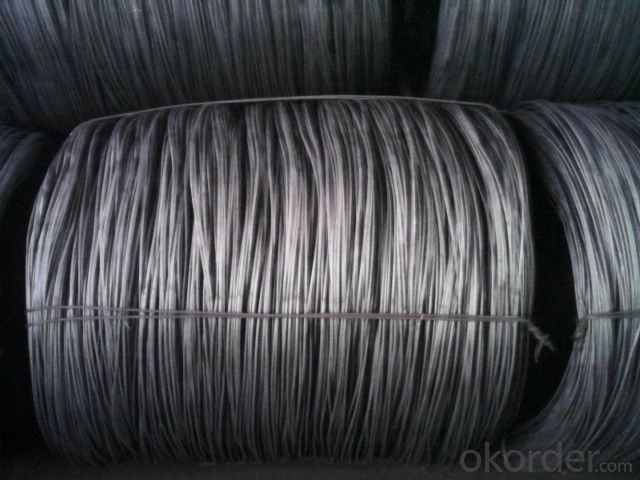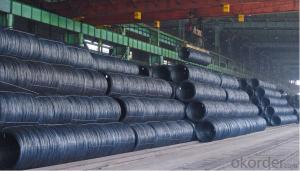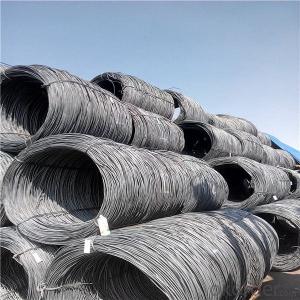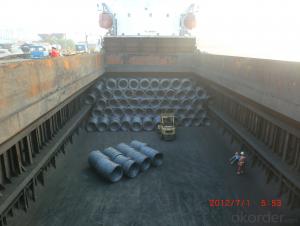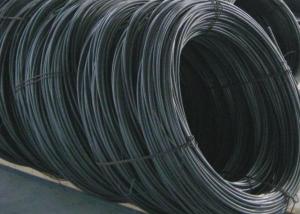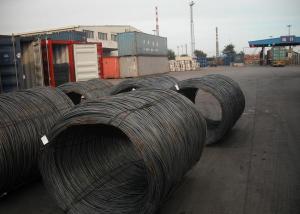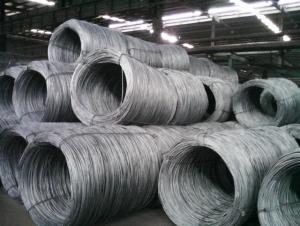China Supplier American Standard Steel Wire Rod
- Loading Port:
- China main port
- Payment Terms:
- TT or LC
- Min Order Qty:
- 50 m.t.
- Supply Capability:
- 200000 m.t./month
OKorder Service Pledge
OKorder Financial Service
You Might Also Like
Specifications of China Supplier American Standard Steel Wire Rod
Steel Grade: Q195/235, SAE1006-1018B Standard: ASTM, GB
Diameter: 5.5mm, 6.5mm, 7mm,8mm,9mm,10mm,12mm,14mm
Type: Drawn Wire Alloy or Not: Alloy Brand Name: HSKY
Technique: Hot Rolled Place of Origin: China Mainland
Chemical Composition of China Supplier American Standard Steel Wire Rod
(Please kindly find our chemistry of our material based on SAE1006B and SAE1008B as below for your information)
Grade | Chemical Composition (%) | |||||
C | Mn | S | P | Si | B | |
SAE1006B | 0.03~O.07 | 0.32max | 0.045max | 0.040max | 0.30max | 0.0008min |
Mechanical properties | ||||||
Yield strength(N/mm2) | Tensile strength(N/mm2) | Elongation (%) | ||||
250-280 | 350-380 | ≥32 | ||||
Grade | Chemical Composition (%) | |||||
C | Mn | S | P | Si | B | |
SAE1008B | 0.10max | 0.3~0.50 | 0.050max | 0.040 max | 0.15max | 0.0008 min |
Mechanical properties | ||||||
Yield strength(N/mm2) | Tensile strength(N/mm2) | Elongation (%) | ||||
≥195 | 315-430 | ≥30 | ||||
Usage and Applications of China Supplier American Standard Steel Wire Rod
After hot-rolled the products shaped into coil and delivery as finished product, including round, square, rectangular, hexagonal and so on, Since most of the products are round, it is generally called wire rod. Steel wire rod is widely used in construction and manufacturing. Steel wire rod is mainly used for reinforcement of reinforced concrete and welded structure or reprocessed (roberts, nail etc) materials, especially used to produce wire drawing, welding electrode, nails,spring, electronic, precise machinery parts and so on.
Packaging & Delivery of China Supplier American Standard Steel Wire Rod
Packaging Detail: products are packed in coil and then shipped by container or bulk vessel
Each coil weight: 2-3MT
Delivery Detail: within 45 days after received deposit or LC.
Label: to be specified by customer, generally, each bundle has 1-2 labels
Trade terms: CFR, CIF
Pictures of China Supplier American Standard Steel Wire Rod
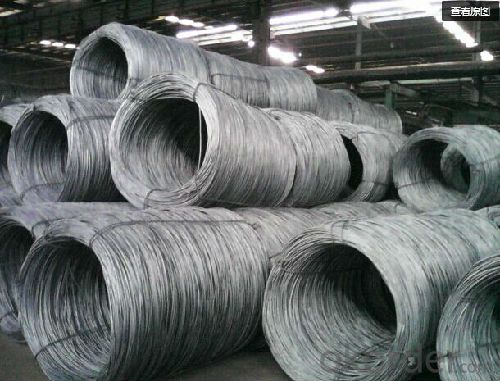
Steel Wire Rod in Coil in Container
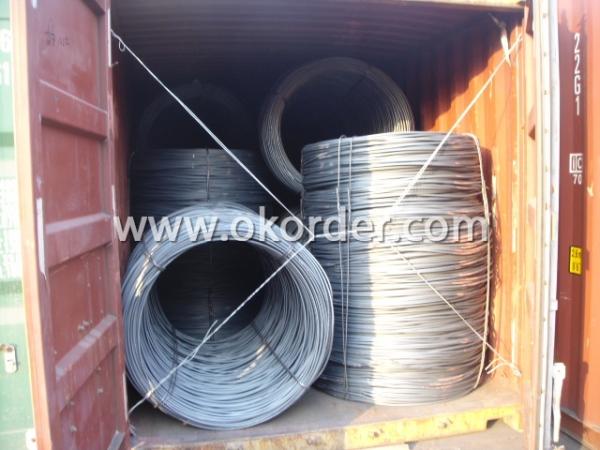
Steel Wire Rod in Coil in Bulk Vessel
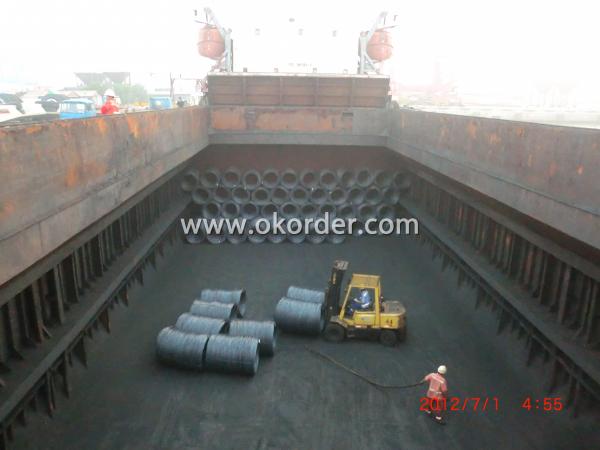
Note:
1. Our products are produced according to national standard (GB), if not, supply according to national standards (GB) or agreement as customer required.
2. Other Grade and Standard carbon steel wire rod we can supply:
Grade: H08A, 30MnSi, 62B-82B
Standard: AISI, BS, JIS, DIN
The Minimum Order Quantity of these products is high, and need to be confirmed.
3. We can not only supply carbon steel wire rod; if you need anything about building materials, please contact us.
4. Please send us your detail specifications when inquire. We will reply to you as soon as possible. We sincerely hope we can establish a long stable business relationship.
- Q: What are the main factors influencing the choice of steel wire rod order warranty claims process?
- The choice of the warranty claims process for steel wire rod orders can vary depending on several factors. Firstly, the quality of the wire rod plays a significant role in determining how often and how straightforward the warranty claims process will be. If the wire rod meets the required standards and is of high quality, there may be fewer claims and a simpler process. Conversely, if the wire rod has inherent flaws or defects, there is a higher likelihood of warranty claims, resulting in a more complex process. Secondly, the terms and conditions of the warranty provided by the supplier or manufacturer can greatly impact the choice of the warranty claims process. The duration, coverage, and any limitations or exclusions of the warranty can influence decision-making. A comprehensive warranty with a reputable supplier can instill confidence in the buyer, making them more likely to choose that specific claims process. Additionally, the availability and efficiency of customer support and after-sales service are crucial factors in deciding the warranty claims process. Responsive and prompt customer support can expedite the claims process, provide guidance, and address any concerns or queries from the buyer. This level of support significantly influences the choice of the warranty claims process, ensuring a smoother and more satisfactory experience. Furthermore, the reputation and track record of the supplier or manufacturer also impact decision-making. Buyers are more likely to select a warranty claims process from a trustworthy supplier with a history of promptly and fairly honoring warranty obligations. This factor provides peace of mind and increases confidence in choosing a particular claims process. Lastly, the cost-effectiveness and convenience of the warranty claims process can play a role in the decision. If the process is affordable and convenient for the buyer, they may be more inclined to choose that specific claims process. This includes factors such as the ease of filing a claim, the time taken for resolution, and any associated costs or deductibles. Overall, the key factors influencing the choice of warranty claims process for steel wire rod orders are the quality of the product, the terms and conditions of the warranty, the availability of customer support, the reputation of the supplier, and the cost-effectiveness and convenience of the process.
- Q: What are the common sizes of steel wire rod?
- The size of steel wire rods differs depending on the specific application and industry requirements. However, there are commonly utilized sizes of steel wire rods with diameters ranging from 5.5mm to 20mm. These sizes are typically employed in the production of various items, including wire ropes, springs, nails, screws, and reinforcement bars for construction purposes. Moreover, steel wire rods can also be found in larger diameters that exceed 20mm, which are suitable for heavy-duty applications such as prestressed concrete structures and suspension bridges. It is worth noting that the sizes of steel wire rods can vary by region and industry standards, so it is advisable to refer to the relevant specifications and standards for accurate information.
- Q: What are the different surface cleaning methods for steel wire rod?
- Steel wire rods can be cleaned using various methods to eliminate impurities and enhance their quality. Some of these methods include mechanical cleaning, chemical cleaning, electrochemical cleaning, ultrasonic cleaning, and steam cleaning. Mechanical cleaning involves using mechanical abrasion, such as wire brushing, sanding, or shot blasting, to eliminate surface impurities like rust or loose particles. Chemical cleaning, on the other hand, utilizes chemicals to dissolve or react with contaminants. Acid pickling is commonly used to remove oxide layers or scale, while alkaline cleaning can eliminate organic impurities. Electrochemical cleaning employs an electrical current, electrolyte solution, and electrochemical pickling or electrocleaning processes to dissolve or dislodge impurities. It is particularly suitable for stainless steel wire rods to maintain their corrosion resistance. Ultrasonic cleaning relies on high-frequency sound waves to create microscopic bubbles that implode on the wire rod's surface, effectively removing contaminants like oils or greases. Steam cleaning employs high-pressure steam to dislodge and eliminate contaminants, making it useful for heavily contaminated wire rods. It is important to consider factors such as the type and severity of contamination, desired cleanliness level, and specific end application requirements when selecting a cleaning method for steel wire rods. Each method has its own advantages and limitations, so choosing the most appropriate one is vital to ensure the highest quality and performance of the wire rod.
- Q: What are the main factors influencing the choice of steel wire rod order payment method?
- The selection of the payment method for steel wire rod orders can vary based on the specific circumstances and preferences of the parties involved. However, there are common factors that typically play a role, including: 1. Transaction volume and frequency: If the buyer and seller have a long-term and high-volume relationship, they may choose a more convenient and efficient payment method, such as open account or letter of credit. This eliminates repetitive paperwork and bank involvement, ensuring smoother and quicker transactions. 2. Trust and creditworthiness: If there is a lack of trust between the buyer and seller, or if the buyer's creditworthiness is questionable, the seller may prefer more secure payment methods like advance payment or documentary collection. These methods provide assurance that payment will be made before the goods are delivered. 3. Cost and convenience: The cost and convenience of different payment methods can also affect the decision. For example, if the buyer wants to avoid additional fees or charges associated with certain payment methods, they may choose cash in advance or electronic funds transfer. Conversely, if the seller wants to minimize administrative burden or payment processing costs, they may prefer open account or electronic payments. 4. Country-specific regulations and customs: Each country has its own regulations and customs regarding international trade and payment methods. For instance, certain countries may restrict certain payment methods or require specific documentation for customs clearance. Sellers and buyers must consider these factors when selecting a payment method. 5. Payment security and risk mitigation: The desired level of payment security and risk mitigation by the buyer and seller can also influence the choice of payment method. Methods like letter of credit or documentary collection offer higher security and risk mitigation compared to open account or cash in advance. 6. Market norms and industry practices: Prevailing market norms and industry practices can also impact the selection of payment methods. In some industries or regions, specific payment methods may be commonly used due to historical practices or preferences. In conclusion, the main factors influencing the choice of payment method for steel wire rod orders include transaction volume and frequency, trust and creditworthiness, cost and convenience, country-specific regulations and customs, payment security and risk mitigation, as well as market norms and industry practices. It is crucial for both the buyer and seller to carefully evaluate these factors in order to select the most suitable payment method for their specific situation.
- Q: What are the common warranty considerations for steel wire rod?
- There are several common warranty considerations for steel wire rod, including the durability and strength of the material, compliance with industry standards and specifications, and the absence of defects such as surface imperfections or dimensional inaccuracies. Additionally, warranties often cover the performance of the wire rod in specific applications, such as its ability to withstand corrosion or maintain its structural integrity over time.
- Q: What is a wire rod?
- Wire rods, also known as wire rods, steel, wire, rod (s), usually refer to small diameter round steel discs. The diameter of the wire rod is in the range of 5-19 millimeters (usually 6-9 mm), and its lower limit is the minimum size of the hot-rolled steel section.
- Q: What are the common defects that can occur during the processing of steel wire rod?
- During the processing of steel wire rod, various defects can arise, impacting the wire rod's properties and performance. Identifying and addressing these defects is of utmost importance. 1. Surface defects, such as scratches, pits, cracks, and scale, can significantly affect the wire rod's appearance and quality. These defects occur due to mishandling, improper rolling, or cooling processes. 2. Internal defects encompass inclusions, voids, and segregation. Inclusions refer to non-metallic particles or impurities weakening the wire rod. Voids are internal cavities that compromise its strength and structural integrity. Segregation involves uneven distribution of alloying elements, resulting in inconsistent mechanical properties along the wire rod's length. 3. Dimensional defects include variations in diameter, ovality, and straightness. These defects occur due to inadequate rolling, cooling, or handling processes, resulting in wire rods that fail to meet required specifications. 4. Decarburization is the loss of carbon from the wire rod's surface during heating or annealing processes. This loss diminishes its strength and hardness, impacting performance in applications requiring high strength. 5. Surface contamination can transpire during the processing of steel wire rod, resulting in foreign materials like oil, grease, dirt, or oxide scales. These contaminants adversely affect the wire rod's surface quality and may cause issues during subsequent processing or applications. To minimize these defects, implementing proper quality control measures throughout the production process is crucial. This involves using high-quality raw materials, employing effective rolling and heat treatment processes, and conducting regular inspections and testing to promptly identify and rectify any defects that arise.
- Q: What are the different types of steel wire rod finishes for improved impact resistance?
- There are several types of steel wire rod finishes that can be applied to improve impact resistance. Some common finishes include galvanized, epoxy coated, and stainless steel. These finishes provide a protective layer that enhances the wire rod's ability to withstand impact and prevent damage.
- Q: What are the different types of steel wire rod drawing dies?
- There are several different types of steel wire rod drawing dies, including single crystal diamond dies, polycrystalline diamond (PCD) dies, natural diamond dies, tungsten carbide dies, and ceramic dies.
- Q: What are the common industry competencies for steel wire rod professionals?
- Some common industry competencies for steel wire rod professionals include knowledge of steel production processes, understanding of quality control and testing procedures, proficiency in operating and maintaining machinery and equipment, familiarity with industry safety regulations, ability to interpret and analyze technical data and specifications, and effective communication and teamwork skills.
Send your message to us
China Supplier American Standard Steel Wire Rod
- Loading Port:
- China main port
- Payment Terms:
- TT or LC
- Min Order Qty:
- 50 m.t.
- Supply Capability:
- 200000 m.t./month
OKorder Service Pledge
OKorder Financial Service
Similar products
Hot products
Hot Searches
Related keywords



